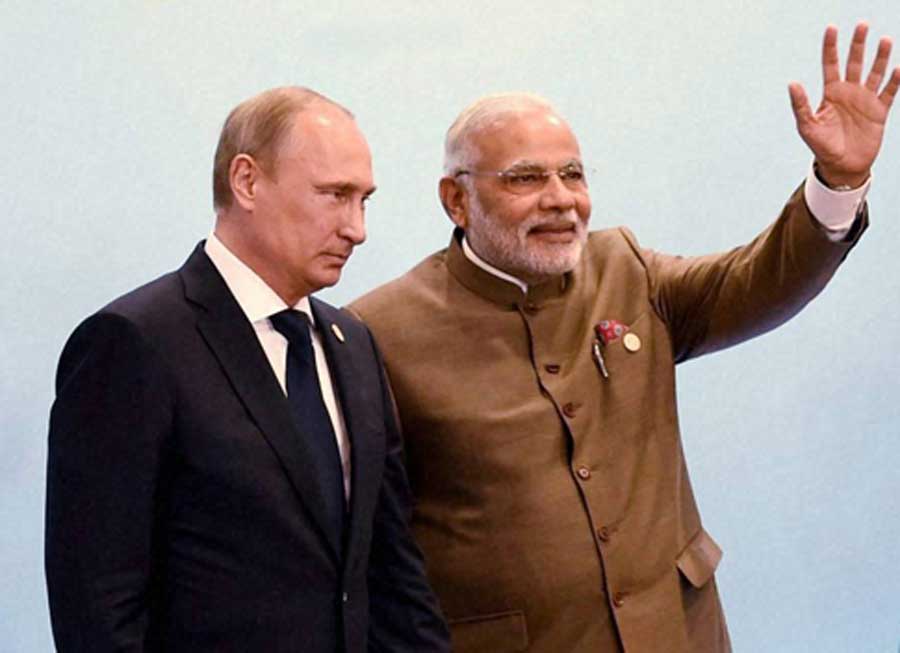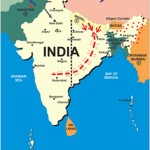After wide-ranging talks between Prime Minister Narendra Modi and President Vladimir Putin, Indian and Russia on October 5, signed $5 billion five S-400 Triumf missile defence system deal in New Delhi bolstering its shield against possible air attacks from Pakistan and China. Modi and Putin also signed eight other pacts, including on cooperation on India’s ambitious human space mission project Gaganyaan, at the 19th India-Russia annual bilateral summit. The signing of defence deal between the two countries comes amid the US warning.
The Russian-built S-400 Triumf — identified by NATO as the SA-21 Growler — is the world’s most dangerous operationally deployed modern long-range surface-to-air missile system, and is considered much more effective than the Terminal High Altitude Area Defence system developed by the US.
| S-400 Triumf Anti-Aircraft Missile Systems Capabilities
The S-400 is a mobile system that integrates multifunction radar, autonomous detection and targeting systems, anti-aircraft missile systems, launchers, and a command and control centre. It can be deployed within five minutes, and is capable of firing three types of missiles to create a layered defence. It can engage all types of aerial targets including aircraft, unmanned aerial vehicles, and ballistic and cruise missiles within a range of 400 km, at an altitude up to 30 km. It can simultaneously track 100 airborne targets, including super fighters such as the US-built F-35, and engage six of them at the same time. The S-400 missile has a range up to 380 km can destroy hostile aircraft, strategic bombers, missiles and drones. Its radars can track hundreds of targets simultaneously and can intercept targets at different ranges. It can even intercept ballistic missiles with a velocity of 4,800 meters per second. It can also “radar lock and shoot down” 5th generation stealth fighters like the US F-35 jets. |
If fighters like Rafale from France are meant to take the war to the enemy the S-400 batteries are designed to prevent the enemy from bringing it to Indian shores by erecting a defensive shield that can detect, track and destroy hostile strategic bombers, jets spy planes, missiles and drones at a range of 380 km.
India’s move to ink the $5.43 billion (Rs 40,000 crore) deal for five advanced S-400 Triumf surface-to-air missile squadrons from Russia on 5 October, despite the looming threat of US sanctions, underlines its resolve to bolster air defence coverage along the unresolved borders with China and Pakistan.
The resolve became stronger after China began inducting six S-400 batteries in January under a $3 billion deal linked with Russia in 2014. The US last month imposed financial sanctions on China for its S-400 deal but India is hopeful for getting a waiver from the Trump administration being its close strategic and trade partner. The US depends on India to counter China in its strategic maneuvers in South China Sea and other areas.
The S-400 missiles are very critical for India’s national security. In terms of configuration India’s S-400 are better than what China is getting. The highly automated and mobile S-400 systems, with four different kinds of missiles with interception ranges of from 150 km to 380 km, will change the dynamics of air defence in the region, however China is getting the older version of S-400.
|
Plan of IAF • IAF will integrate S-400 with its Integrated air command and control system (IACCS) network of censors and weapons. • Missile shield will have inner ring of S-400, with outer layer of under-development indigenous two-tier ballistic missile shield against 1500 km range missiles. |
India will pay only 15 per cent (Rs 6,000 crore) to Russia as the first installment, with the rest being linked tocycle of deliveries. IAF is slated to get the first S-400 missile squadron in 24 months, with its associated battle management system of command post and launchers, long-range acquisition and engagement radars, and all terrain transport-erector-launcher vehicles. All five squadrons, with two firing units each, will arrive in 54 months.
The S-400, with their huge ‘area denial capabilities’ are much of a game changer as the Rs 59,000 crore procurement of 36 Rafale fighters from France, which has run into a political dogfight between BJP and Congress. S-400 is certainlymore formidable than the US Patriot or any other air defence system around the world. The combination of 36 Rafale fighter jets and S-400 missiles will be a very strong weapon system force to reckon with India to defeat any two pronged offensive from China and Pakistan.
When deployed near the border with Pakistan it can shoot down a hostile F-16 fighter or cruise missile much before it comes anywhere near Indian air space during hostilities. It can even take out intermediate range ballistic missiles with a velocity of 4,800 meters per second. It will be crucial in providing multilayer defence for cities like Delhi, Mumbai, Chennai and Kolkata.
|
Other Countries Contracts of S-400 Missile Systems • China inducting six S-400 missile batteries under $3 billion deal with Russia. • Turkey to get S-400 missile from 2019 under $2.5 billion deal from Russia. • Saudi Arabia and Qatar and a number of other Arabian countries are negotiating for S-400 missiles with Russia |
The S-400 contract is the largest-ever defence deals inked with Russia. The other big deals include the ones for 272 Sukhoi-30 MKI fighters (over $12 billion) and INS Vikramaditya.
The issue of whether India would disregard the US threat of applying sanctions under the Countering America’s Adversaries Through Sanctions Act (CAATSA) after inking $5 billion defence system deal had dominated attention of the Modi-Putin annual summit. Though the US had earlier this weak cautioned countries against helping the Russian economy by buying weapon systems from them yet India has sealed the deal in view of its urgent needs of defence modernisation requirements.The US has urged its allies to forgo transactions with Russia, warning that the S-400 missile defence system that India wanted to buy would be a ‘focus area’ for it to implement punitive sanctions against a nation undertaking ‘significant’ business deals with the Russians. American lawmakers, however, have allowed the possibility of a presidential waiver. However, Trump is unpredictable and if sanctions are imposed on India, the US will suffer more than India as India is its one of the largest trading countries resulting a great economic loss to the US. Hopefully the Trump administration will give waiver to India considering its dire strategic defence requirements. Moreover Russia is the major country that has been supporting India at the UN on the Kashmir issue even used Vetoes during adverse verdicts against India. Indo-Russian joint military exercises have been carried out in the recent past for planning joint strategies.
Moments after India and Russia signed S-400 deal air defence system deal; the US embassy in India said that the US sanctions were aimed to punish Russia, not to damage military capabilities of ‘our allies’.
Speaking over Indo-Russia bilateral trade ties, Prime Minister Narendra Modi said that Russia could become our partner in the new and renewable energy sector. He said that the world has changed but the relationship between India and Russia has remained same and the trade between the two countries has risen to 20 per cent in 2017-18.
Talks with President Putin have given new direction to the bilateral strategic partnership, Modi said in a press statement after the 19th India-Russia annual summit. Pacts were also inked in the fields of space, nuclear energy, railways and space. A crucial MoU was signed between Indian Space Research Organization (ISRO) and the Federal Space Agency of Russia ‘ROSCOSMOS’ on joint activities in the field of human spaceflight programme Gaganyaan. India is planning to send an astronaut in the space by 2022 for which Russia is going to be a great help.
India and Russia are committed to cooperating in the fight against terrorism, Modi said. President Putin said the two countries have agreed to step up cooperation in combating the menace of terrorism and drug trafficking. Drug trafficking and antiterrorism are the most important worries for India to tackle.
Kudankulam plant in Tamil Nadu
Russia pitches for Indian energy companies to invest in its country. Putin says he and Modi have discussed in detail Kudankulam nuclear power plant in Tamil Nadu–the fourth and fifth units of the plant are being constructed and the fourth and fifth will be constructed next. He adds that according to India’s agreement with Russia, 12 units will be built in the next 20 years.
Discussed increasing mutual investments up to $15 billion: PutinMutual trade grew by 21 per cent last year exceeding $9 billion, and this year it has been 20 per cent, says Putin. ‘If we proceed moving at this pace, we will reach our goal faster,’ Putin says. India is where Russia finds friendship, mutual respect and sympathy. The joint statement outlines plans and prospects for a long time, he adds.
We must continue cooperation in international organisations, PM Modi tells Russian President. He adds that there will be an increase if our ties after today’s discussion, and help increase peace and stability in this world in these challenging times. “I can say with full confidence, that our friendship is unique,” he says as he concludes speaking.
Your visit has helped our ties. Today, the decisions we have taken will give impetus to our relations. From trade, investment, technology and energy, to economic cooperation, our relations are now diversified, PM Modi said. ‘We have taken ties beyond the conventional dimension. Russia has always stood by India,’ he adds.
The Modi-Putin summit will be a game changer in the international conflict settling of disputes in the region.





